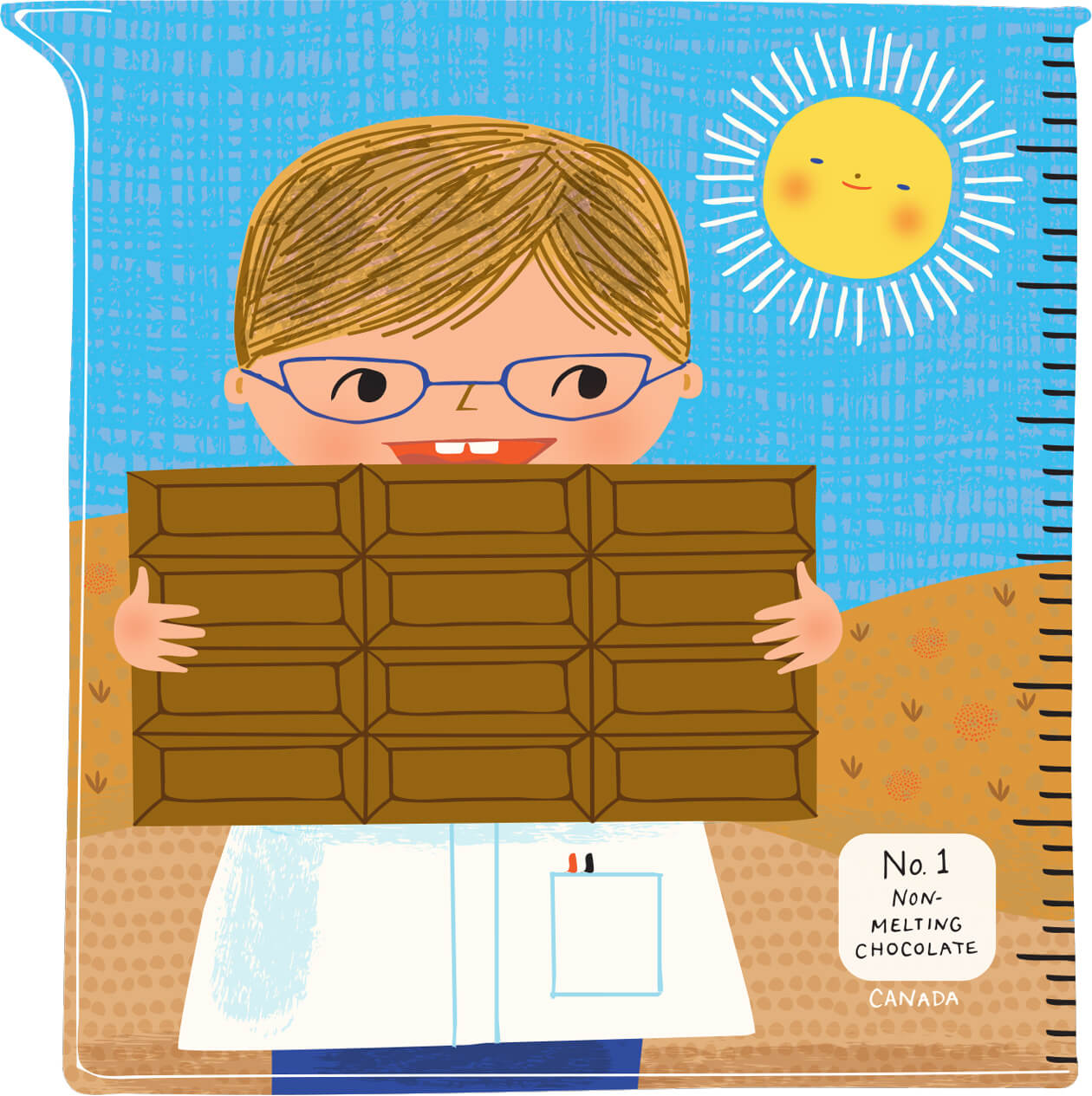In april of 1937, United States Army captain Paul Logan met with the president of Hershey to discuss the possibility of developing a chocolate bar that wouldn’t melt in soldiers’ pockets. His list of requirements was straightforward: he wanted something that would keep its shape in high temperatures and taste “just a little” better than a boiled potato. The final product was a bitter, paste-like concoction that practically turned to dust on eating, but its high calorie count and ability to withstand 50 degree Celsius heat made it an ideal emergency ration for troops in World War II. Captain Logan deemed the experiment a great success and called for the bars to be produced by the thousands.
Throughout the war, Hershey’s rival Mars supplied American troops with another option: M&M’s. Regular chocolate melts at 34 degrees Celsius, just below body temperature. An M&M’s candy shell, with its higher melting point, protects its chocolate filling, hence the brand’s slogan: “The milk chocolate that melts in your mouth, not in your hand.” In spite of the popularity of the product—at one point, suppliers produced 12 million M&M’s per hour to keep up with demand—Hershey’s status at the time as the biggest manufacturer of chocolate in North America cemented the company’s image, in newspapers and in the public mind, as the official supplier of fortifying snacks for the military. A decades-long chocolate war began.
Chocolate has been a staple of the Western diet since the first edible bar was produced more than 150 years ago. However, there are specific barriers that hold back the widespread culture of chocolate eating. In some Chinese cities, for example, temperatures can reach 40 degrees Celsius during the summer, and a lack of climate-controlled transportation and storage restricts distribution. The first company to produce a good-tasting chocolate bar that can survive high temperatures could dominate the market in China—with its 1.4 billion potential consumers—and, from there, other countries with large populations and hot weather. The markets for chocolate in the Asia-Pacific region, Latin America, the Middle East, and Africa are expected to grow by more than 50 percent to reach $48 billion (US) by 2019.
The difficulty in creating non-melting chocolate bars lies in the nature of chocolate itself. Making chocolate is a laborious process that requires melting and cooling the mixture to evenly distribute fat—the thing that gives a Hershey bar its rich and satisfying mouthfeel. For years, many food scientists assumed that the way to increase chocolate’s heat resistance was to build up its consistency; the thicker the mix, the better. Manufacturers tried taking out the cocoa butter and replacing it with temperature-stable alternatives.
In one of the landmark books on the chocolate war, Joël Glenn Brenner’s The Emperors of Chocolate: Inside The Secret World of Hershey and Mars (1998), a former Hershey factory employee recalls the physical strength it took to press the original chocolate recipe into moulds: “That bar could kill you if you weren’t careful.” When Hershey removed oat flour from its ingredient list in the late 1950s, the company was on track to finding a better-tasting bar (one that was sent to the moon in 1971 with Apollo 15 astronauts). Three decades later, during the Persian Gulf War, Hershey’s new Desert Bar introduced egg whites, giving the chocolate a fudge-like texture that enabled it to withstand the Arabian sun. More than 100,000 one-ounce bars were shipped to the troops. However, soldiers on the ground continued to request the familiar-tasting Mars chocolate that was also sent their way.
In 1991, after the Gulf War had ended, Mars got a contract with the Pentagon to produce non-melting chocolate. This didn’t sit well with Hershey, which accused its rival of violating FDA laws surrounding sugar allowance. Mars’s general counsel, Edward J. Stegemann, called them “lying SOBs” in response. The months that followed were filled with accusations and lawsuits. Mars threatened to sue Hershey for defamation. Then Hershey threatened to sue right back for product misrepresentation. “The way Hershey was complaining, you’d have thought Mars was breaching national security by selling military secrets,” said Paul Lieberman, the attorney who settled the government contract.
Although the search for a heat-resistant chocolate bar continued for decades, it never resulted in a bar that could rival the real thing. The final product has always been too chalky, too waxy, or too bitter. It wasn’t until the ’80s that the industry finally started to narrow in on the real answer, which was to alter chocolate’s granular structure. A small research firm in New Jersey was the first to patent such technology back in 1987. However, no company has ever had a real opportunity to produce palatable non-melting chocolate on a commercial scale—until now.
At the University of Guelph, on the second floor of what used to be a cheese factory, Alejandro Marangoni and a PhD student meticulously measure melted chocolate into glass beakers. A refrigerator hums in the background, and sun streams in through the old windows, reflecting off the stainless-steel countertops. By noon, they’ve made dozens of samples that look just like ordinary chocolate squares. But this chocolate isn’t melting in the sun.
“It took three years to refine,” Marangoni says. For someone who got back from a mountain-climbing expedition in Colombia less than twenty-four hours ago, he’s enthusiastic and energetic. Marangoni compares mountain climbing to performing research: both take patience and require you to keep pushing forward at all times.
In the 1990s, Marangoni became interested in the growing popularity of fat and oil research. Later, he started looking at a chemical called ethyl cellulose, which, when processed for chocolate-making, turns into a Jell-O-like substance that can imitate fat. “All of a sudden, the chocolate wasn’t melting or losing its shape, and then we thought, ‘Wow, we have something here.’”
Marangoni also discovered that ethyl cellulose can act like a glue and make sugar crystals stick together. Particle by particle, a chemical reaction creates a resilient structure within the chocolate—one that holds together the fat in the bar, even on the hottest of summer days. It isn’t until someone takes a bite that the sugar structure dissolves, releasing the fat inside. The chocolate will melt only where it’s supposed to: in your mouth.
Mars, the current leader in the Chinese market, has bought the patent for Marangoni’s technology. They are now working on refining the product for commercial release. “The science was the first step, but to actually get the quality right is the hard part,” Marangoni says. “There were all sorts of flavour issues.” One of their first challenges was figuring out how to neutralize the alcohol-like taste of ethyl cellulose. The most recent sample he tested checked all the boxes: it finally looked and felt like chocolate.
Other companies are racing towards the same goal. Hershey filed a patent in 2014 for a method that uses chocolate “dough” (ingredients are milled into tiny particles; as the powder is agitated in fat, the two materials become more likely to stick together—eventually forming that essential sugar structure), and Nestlé and Cadbury have also announced new experiments. “It’s a war out there,” Marangoni says.
When a heat-resistant bar with mass appeal becomes publicly available, which Marangoni suspects could be any day now, chocolate companies will face another challenge: convincing Chinese consumers to eat chocolate for the reasons North Americans do. In the West, chocolate is more than a dessert or an energy-giving snack: it’s a symbol of love and affection. How do you sell those associations to a culture that has never linked them to chocolate? The answer may be found in a famous Chinese proverb—min yi shi wei tian, “for people, food is heaven.” What’s important in life is a full stomach and a happy heart. The question that remains is which company will be the first to supply them.
This appeared in the January/February 2017 issue under the headline “Melts in Your Mouth.”






